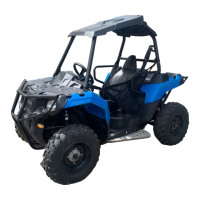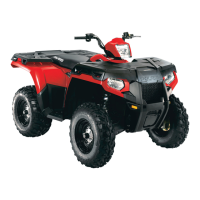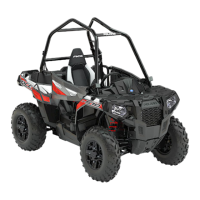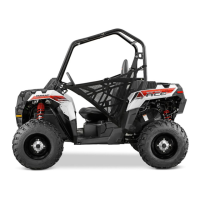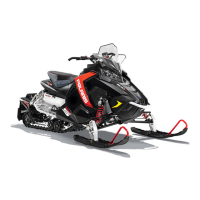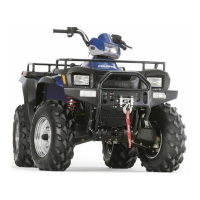
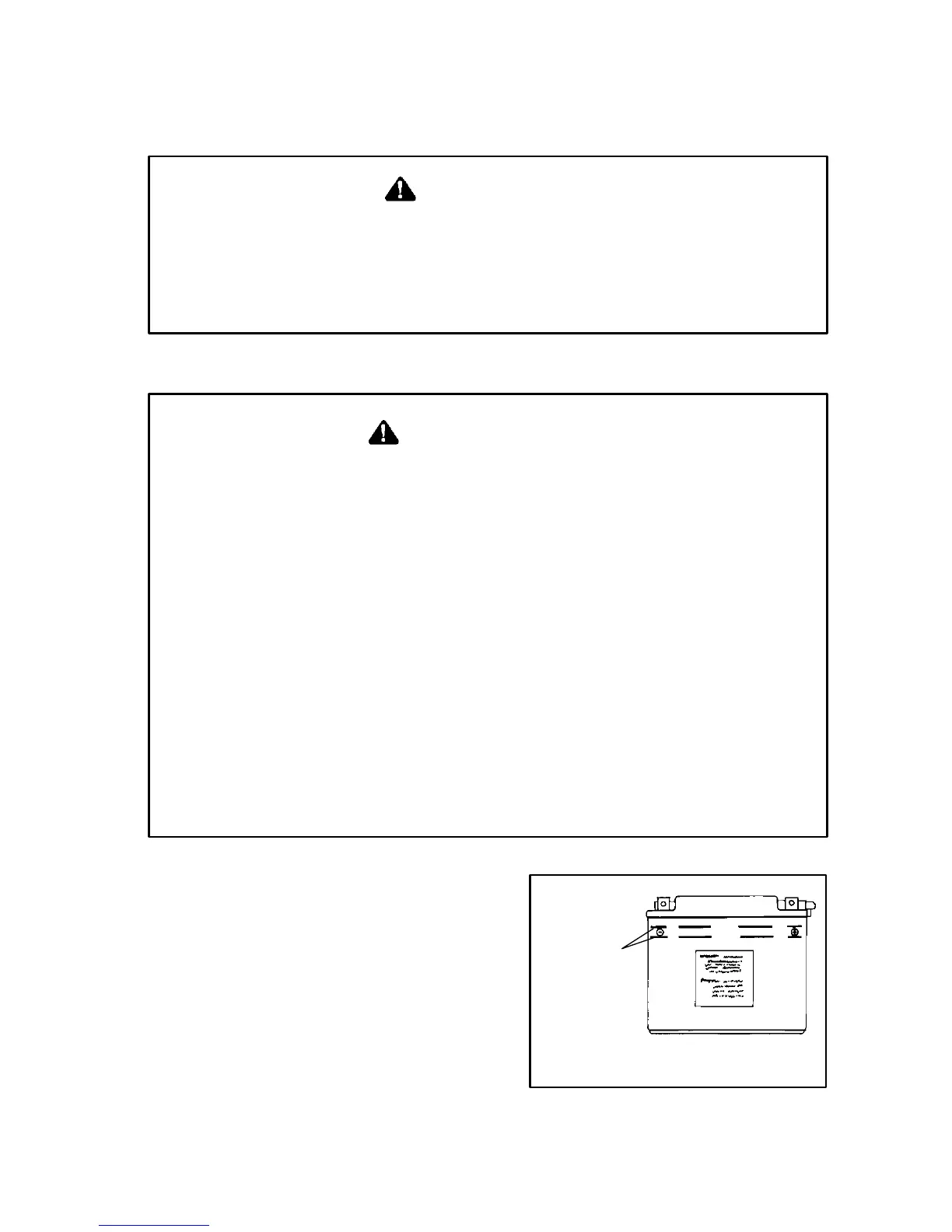
Do you have a question about the Polaris ATV 2002 and is the answer not in the manual?
| Brand | Polaris |
|---|---|
| Model | ATV 2002 |
| Category | Offroad Vehicle |
| Language | English |
Information about Polaris's commitment to excellence in recreational vehicles.
Details on how to purchase Polaris parts, apparel, and accessories online.
Warning that the vehicle is for adult use only and operation by minors is prohibited.
Importance of completing a safety training course for proper ATV operation.
Location of the Frame VIN on the ATV for identification purposes.
Location of the Engine Serial Number on the ATV for identification purposes.
Identifies the safety alert symbol and its purpose for personal injury warnings.
Explains meanings of WARNING, CAUTION, and NOTE signal words in the manual.
Guidelines for responsible riding to maintain the sport's integrity and respect.
Highlights that ATVs are not toys and can be hazardous to operate.
Stresses the importance of proper instruction and training before operating the ATV.
Prohibits operation by those under 16 and requires guest training.
Advises avoiding paved surfaces and public roads for ATV operation.
Mandates wearing approved helmets, eye protection, gloves, boots, and protective clothing.
Prohibits alcohol or drug consumption before or during ATV operation.
Advises against excessive speeds and stunts like wheelies.
Emphasizes pre-ride inspection and maintaining control with both hands and feet.
Advises caution on unfamiliar terrain, slippery surfaces, and in changing conditions.
Provides guidance on proper turning techniques and caution when operating through water.
Describes warning decals placed on the vehicle for rider protection and instructions.
Covers critical warnings like no public roads, no passengers, no alcohol/drugs, and proper training.
Shows locations of decals related to handlebar controls and operational warnings.
Advises on safe hill operation, reverse use, and parking brake precautions.
Outlines essential protective gear including helmet, eye protection, gloves, boots, and clothing.
Emphasizes that operating without proper instruction greatly increases accident risk.
Warns that failure to follow age recommendations can lead to severe injury or death.
States that carrying a passenger is prohibited as it affects balance and control.
Warns that ATVs are for off-road use; paved surfaces affect handling and control.
Prohibits operating the ATV on public streets, roads, or highways due to collision risks.
Stresses wearing approved helmets, eye protection, and proper clothing to prevent severe injury.
Prohibits alcohol or drug use as it impairs judgment, reaction, and balance.
Warns that excessive speeds increase the risk of losing control and causing accidents.
Discourages stunts like wheelies and jumps due to increased accident and overturn risk.
Emphasizes pre-ride inspection and proper maintenance for accident prevention.
Advises keeping both hands on handlebars and feet on footrests during operation for control.
Advises slow speeds and alertness on unfamiliar terrain to avoid hidden obstacles.
Warns against excessively rough, slippery, or loose terrain without proper skills to avoid loss of control.
Warns that improper turning can cause loss of control, collision, or overturn.
Advises against operating on hills too steep for abilities or exceeding 25 degrees.
Details safe hill climbing, including terrain checks, weight transfer, and avoiding sudden throttle.
Guides on safe hill descending, including terrain checks, weight transfer, and speed control.
Warns about risks of crossing or turning on hills and advises mastering techniques on level ground.
Provides procedures for stalling or rolling backwards while climbing a hill to prevent overturn.
Advises checking for obstacles and using caution when riding over them to prevent loss of control.
Warns that skidding or sliding can cause loss of control and potential overturn.
Advises against deep water; if unavoidable, proceed slowly, balance weight, and test brakes after.
Warns that improper tires or pressure affect handling and increase accident risk.
Advises against improper modifications as they can affect handling and lead to accidents.
Recommends dealer inspection after a rollover for damage to critical components.
States safe operation requires good judgment and physical skills; disabilities increase risk.
Warns that leaving keys in ignition can lead to unauthorized use and injury or death.
Describes the override switch, main switch, and engine stop switch functions.
Explains throttle lever operation and choke usage for starting.
Explains brake operation and pre-ride lever functionality checks.
Details brake fluid checks and the Electronic Throttle Control (ETC) system.
Details setting the parking brake and important safeguards.
Explains auxiliary brake operation and fluid level checks.
Explains fuel system operation and safety precautions for gasoline.
Lists safety practices for refueling, including ventilation and no smoking.
Specifies using only Polaris injection oil for two-cycle engines.
Explains shift patterns, selector lever positions, and low forward gear usage.
Details manual shift procedures and the brake start feature.
Describes shift pedal functionality and provides a gears shifting procedure.
Explains shifting to reverse and notes the lack of highway lighting.
Details procedures for shifting from reverse to forward and for deceleration.
Explains using the recoil starter for operation when the battery is weak.
Describes the Demand 4 Drive (AWD) system activated by a switch for enhanced traction.
Provides instructions on disengaging front wheel hubs if they remain engaged after use.
Explains the function of various indicator lights like Neutral, Reverse, and Oil Warning.
Details the speedometer's functions including distance, trip, hours, and reverse speed limit.
Explains two methods to access the speedometer's sub-menu for settings and features.
Guides on setting service reminders based on programmed hours or distance.
Describes auxiliary power outlets for operating accessories like spot lights.
Provides a comprehensive checklist for verifying the machine's working order before each ride.
Outlines essential procedures for the break-in period of new 2-cycle engines for optimal performance.
Details the break-in period for 4-cycle engines, focusing on careful treatment for longevity.
Provides a step-by-step guide for starting a cold engine, including choke and fuel valve usage.
Explains how to properly warm up the engine after starting to prevent damage.
Advises on evenly distributing cargo weight (1/3 front, 2/3 rear) for stable driving.
Lists crucial safeguards for carrying loads, including reducing speed, proper distribution, and securing loads.
Ensures the machine is in proper working order before riding.
Practice making turns at slow speeds with proper body lean.
Provides advice for riding on slippery surfaces to prevent turnover.
Guides on traveling uphill safely, emphasizing straight alignment and weight transfer.
Warns against sidehilling and provides safety steps if necessary.
Advises on descending hills safely, focusing on driving straight and weight transfer.
Details the K-turn maneuver for turning around while climbing a hill.
Provides guidelines for safely operating the ATV through water.
Emphasizes staying alert for hazards like logs and rocks on trails.
Offers tips for safe backing procedures, including avoiding steep inclines and sharp turns.
Provides instructions for safely parking the ATV on an incline.
Outlines intervals for checks like transmission oil, battery, and engine breather filter.
Covers drive chain condition/slack and steering inspection for looseness.
Specifies monthly checks and annual changes for transmission oil.
Details checks for fuel leaks, fuel valve, filter, pump, and carburetor.
Specifies inspection/adjustment of ignition timing and annual fuel filter replacement.
Details inspection and tightening of front/rear suspension and drive chain.
Covers lubrication of front drive axle U-joints, ball joints, and A-arm pivot shafts.
Recommends Polaris Premium 2-Cycle and 4-Cycle oils, warning against mixing brands.
Specifies DOT 3 brake fluid and Polaris Premium Synthetic gear case lube for transmission.
Details lubrication for front gearcase, prop shaft U-joints, and yoke.
Covers lubrication of rear axle bearings, swing arm bushings, and control arms.
Advises checking and changing oil in the counterbalance housing annually.
Covers lubrication of rear axle bearings, swing arm bushings, and control arms.
Details inspection/adjustment of ignition timing and fuel system checks.
Covers inspection/replacement of drive belt and steering lubrication.
Details inspection and tightening of suspension components and drive chain.
Explains how to measure toe alignment and the recommended toe-out specification.
Details how to adjust handlebars for personal fit, including bolt torque specifications.
Lists recommended checks for the front brake system, including fluid level and pad wear.
Advises changing rear brake pads when worn and inspecting disc spline.
Details adjusting the carburetor idle screw for optimal engine RPM on 2-cycle engines.
Explains adjusting the carburetor idle screw for optimal engine RPM on 4-cycle engines.
Describes the appearance of a normal spark plug insulator tip indicating proper operation.
Provides instructions for removing and installing spark plugs, including torque specifications.
Outlines steps to take if the ATV is immersed in water, including drying and dealer service.
Lists safety precautions for working with the spark arrestor, emphasizing heat and fire hazards.
Outlines owner responsibilities for PVT system safety, including no modifications and routine maintenance.
Provides instructions for drying the PVT system if water has been accidentally ingested.
Explains how to check and maintain battery fluid levels using distilled water.
Details the correct order for connecting battery cables to prevent explosions and injury.
Advises on removing, charging, and storing the battery in a cool, dry place for long-term storage.
Provides instructions for removing and reinstalling side panels on Gen IV models.
Advises on safe ATV washing methods, recommending a garden hose and mild soap.
Recommends using non-abrasive paste wax and avoiding harsh cleaners that can scratch the finish.
Details cleaning, stabilizing fuel, changing oil/filter, and checking fluid levels before storage.
Explains fogging the engine with oil for protection during storage.
Guides on checking battery fluid levels monthly and charging as needed during storage.
Recommends testing engine coolant strength and changing it every two years.
Details the procedure for removing, cleaning, and reinstalling the air filter and pre-filter.
Explains how to clean the main air filter, including warnings about water immersion.
Details removing, inspecting, and reinstalling the breather filter and hose.
Advises periodic inspection of the steering assembly for loose nuts and bolts.
Explains how to measure toe alignment and the recommended toe-out specification.
Describes adjusting the rear shock absorber spring tension by rotating the adjuster cam.
Details how to adjust handlebars for personal fit, including bolt torque specifications.
Lists recommended checks for the front brake system, including fluid level and pad wear.
Advises changing rear brake pads when worn and inspecting disc spline.
Details adjusting the carburetor idle screw for optimal engine RPM on 2-cycle engines.
Explains adjusting the carburetor idle screw for optimal engine RPM on 4-cycle engines.
Provides instructions for safely removing ATV wheels, including loosening lug nuts and using a stand.
Details installing wheels, tightening lug nuts according to torque specifications, and checking valve stem position.
States that front wheel bearing tightness and spindle nut retention require authorized dealer service.
Guides on inspecting the drive chain for O-rings and rollers, and lubricating it with proper lube.
Explains how to check and adjust chain slack, specifying the correct deflection amount.
Provides detailed steps for adjusting rear drive chain tension using eccentric bolts.
Explains how altitude and temperature affect engine performance and potential carburetor adjustments.
Details how to replace the headlight bulb on Scrambler models.
Guides on adjusting headlight aim by measuring distance from the wall and setting beam intensity.
Instructions for replacing the headlight bulb on Trail Blazer models.
Step-by-step guide for replacing the headlight lamp on Gen IV models.
Guides on adjusting headlight aim on Gen IV models using the adjustment knob.
Details replacing the taillight/brakelight bulb if it is not working.
Describes the appearance of a normal spark plug insulator tip indicating proper operation.
Provides instructions for removing and installing spark plugs, including torque specifications.
Outlines steps to take if the ATV is immersed in water, including drying and dealer service.
Lists safety precautions for working with the spark arrestor, emphasizing heat and fire hazards.
Outlines owner responsibilities for PVT system safety, including no modifications and routine maintenance.
Provides instructions for drying the PVT system if water has been accidentally ingested.
Explains how to check and maintain battery fluid levels using distilled water.
Details the correct order for connecting battery cables to prevent explosions and injury.
Advises on removing, charging, and storing the battery in a cool, dry place for long-term storage.
Provides instructions for removing and reinstalling side panels on Gen IV models.
Advises on safe ATV washing methods, recommending a garden hose and mild soap.
Recommends using non-abrasive paste wax and avoiding harsh cleaners that can scratch the finish.
Details cleaning, stabilizing fuel, changing oil/filter, and checking fluid levels before storage.
Explains fogging the engine with oil for protection during storage.
Guides on checking battery fluid levels monthly and charging as needed during storage.
Recommends testing engine coolant strength and changing it every two years.
Details the procedure for removing, cleaning, and reinstalling the air filter and pre-filter.
Explains how to clean the main air filter, including warnings about water immersion.
Details removing, inspecting, and reinstalling the breather filter and hose.
Advises periodic inspection of the steering assembly for loose nuts and bolts.
Explains how to measure toe alignment and the recommended toe-out specification.
Describes adjusting the rear shock absorber spring tension by rotating the adjuster cam.
Details how to adjust handlebars for personal fit, including bolt torque specifications.
Lists recommended checks for the front brake system, including fluid level and pad wear.
Advises changing rear brake pads when worn and inspecting disc spline.
Details adjusting the carburetor idle screw for optimal engine RPM on 2-cycle engines.
Explains adjusting the carburetor idle screw for optimal engine RPM on 4-cycle engines.
Provides instructions for safely removing ATV wheels, including loosening lug nuts and using a stand.
Details installing wheels, tightening lug nuts according to torque specifications, and checking valve stem position.
States that front wheel bearing tightness and spindle nut retention require authorized dealer service.
Guides on inspecting the drive chain for O-rings and rollers, and lubricating it with proper lube.
Explains how to check and adjust chain slack, specifying the correct deflection amount.
Provides detailed steps for adjusting rear drive chain tension using eccentric bolts.
Explains how altitude and temperature affect engine performance and potential carburetor adjustments.
Details how to replace the headlight bulb on Scrambler models.
Guides on adjusting headlight aim by measuring distance from the wall and setting beam intensity.
Instructions for replacing the headlight bulb on Trail Blazer models.
Step-by-step guide for replacing the headlight lamp on Gen IV models.
Guides on adjusting headlight aim on Gen IV models using the adjustment knob.
Details replacing the taillight/brakelight bulb if it is not working.
Describes the appearance of a normal spark plug insulator tip indicating proper operation.
Provides instructions for removing and installing spark plugs, including torque specifications.
Outlines steps to take if the ATV is immersed in water, including drying and dealer service.
Lists safety precautions for working with the spark arrestor, emphasizing heat and fire hazards.
Outlines owner responsibilities for PVT system safety, including no modifications and routine maintenance.
Provides instructions for drying the PVT system if water has been accidentally ingested.
Explains how to check and maintain battery fluid levels using distilled water.
Details the correct order for connecting battery cables to prevent explosions and injury.
Advises on removing, charging, and storing the battery in a cool, dry place for long-term storage.
Provides instructions for removing and reinstalling side panels on Gen IV models.
Advises on safe ATV washing methods, recommending a garden hose and mild soap.
Recommends using non-abrasive paste wax and avoiding harsh cleaners that can scratch the finish.
Details cleaning, stabilizing fuel, changing oil/filter, and checking fluid levels before storage.
Explains fogging the engine with oil for protection during storage.
Guides on checking battery fluid levels monthly and charging as needed during storage.
Recommends testing engine coolant strength and changing it every two years.
Provides a flowchart for diagnosing issues when the engine turns over but fails to start.
Offers solutions for when the engine stops or loses power, covering fuel, spark, and overheating.
Addresses issues related to clutch drive belts and covers, including slippage and malfunctions.
Provides guidelines for using Low Range and High Range based on speed and terrain.
Outlines the six-month limited warranty on ATV components against defects in material or workmanship.
Stresses the need for completing an ATV safety training course and proper dealer registration for warranty validity.
Specifies exclusions from the warranty, including accidental damage, abuse, and unauthorized modifications.
Instructs owners to take the ATV to an authorized Polaris dealer for warranty service with their registration form.
Emphasizes using only Polaris engine oil to maintain warranty coverage and avoid engine damage.




